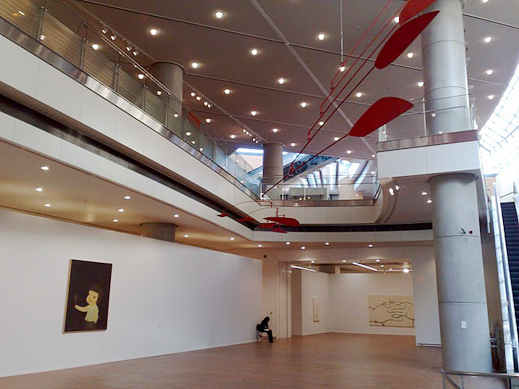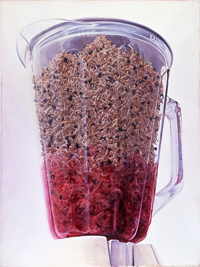 |
Yoshitomo Nara's The Little Judge (left) greets visitors as they descend the escalator to the entrance of "Garden of Painting" at the National Museum of Art, Osaka
Photo by Edan Corkill |
|
|
At the press conference for "Garden of Painting: Japanese Art of the 00s," curator Atsuhiko Shima explained that it took him quite a while to decide on a title for his exhibition. "To begin with, I wanted a cool title, like 'Superflat' or 'Micropop,' but I realized that such a title doesn't fit my personality too well, so I went for the Japanese Kaiga no Niwa (Garden of Painting)," he said.
Shima's attempt to distinguish his handiwork from "Superflat" and "Micropop" was significant, but not because of anything it said about the coolness of his or their exhibition titles.
"Superflat," which was curated by Takashi Murakami and held at Parco Museum in 2000 (before touring elsewhere), and "Micropop," which was curated by Midori Matsui and held at Art Tower Mito in 2007, had one thing in common: they were overt and ambitious attempts to capture two movements in Japan's contemporary art. They were, if you like, attempts to illustrate theories that their curators had developed.
By setting his show apart from those two, Shima was making a simple, albeit coded, statement: there is no theory behind "Garden of Painting." It does not attempt to highlight and analyze any movement from the decade. Instead, it is a sample of painting from the period. The fact that it contains mostly figurative painting is "simply because a lot of people were making figurative art."
Shima's unpretentious approach has its virtues. For one, it means we are free to judge the art for ourselves. In designing the show, he elected to cordon off "mini-galleries" for each artist and show around 10 to 20 of their works. The result is like having 28 solo shows in one venue.
But the very fact that these solo shows are all in the same venue means that viewers will inevitably notice similarities among them. I can't help thinking I would have liked a bit more guidance, particularly in interpreting them as a group. What, for example, do they tell us about the society from which they emerged?
The works have many things in common. What should we make of the plethora of animal-inhabited, fantasy-like vistas, for instance? Sakae Ozawa's paintings seem like illustrations of fables, with a sleeping donkey-man in The drunkard (2008) and animals surrounding a bonfire in Lonely? Me too (Quiet explosion of feelings) (2008). Takeshi Makishima's are similar: in Gravity and Profile (2009) a boy seems to have been adopted by a pack of foxes.
 |
Makoto Aida, Blender (2001)
Acrylic on canvas 290.0×210.5cm
Takahashi Collection
©AIDA Makoto
Photo: Keizo Kioku
Courtesy of Mizuma Art Gallery |
There are also a lot of paintings depicting figures that are turned away from the viewer and appear to be heading solemnly into ominous blankness. In Mitsuhiro Ikeda's untitled (2007), two figures are receding into a flood of light at the end of a cave. In Takashi Masaki's From DRIVING to DRIVING 03-7 (2003), a cap-wearing figure -- also facing away from the viewer -- is submerged to the armpits in blackness. There's also Makoto Aida's well-known AZEMICHI (a path between rice fields) (1991), with a school girl's part aligning perfectly with the path along which she is about to walk. There are others, too.
Where are all these funereal figures headed? And what was it about the 00s in Japan that created them? Most are solitary and all appear youthful. The obvious interpretation is of some kind of alienation felt by the young within their own society. If so, is it the case that they have to resort to fantasy -- the kind of fantasy where animals dance around bonfires and foxes adopt human friends -- for comfort?
All are questions that spring to mind as one meanders through this "Garden of Painting." In some ways it's a disquieting experience -- which is all the more reason it would be nice to have a little guidance from the curator. That's not to say we need anything "cool," of course -- far from it. There need not be anything "cool" about the serious task of interpreting the work of a generation of artists coming of age in troubled times.
|